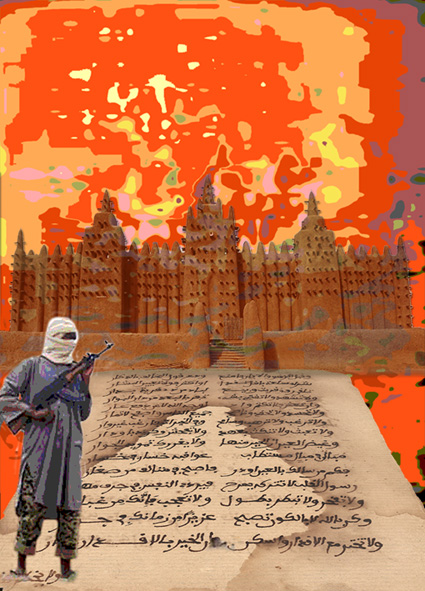A 1000 years old city of the southern edge of the Sahara desert.It was formerly a major trading centre for gold and salt on the trans-Saharan trade routes, reaching the height of its prosperity in the 16th century but falling into decline after its capture by the Moroccans in 1591.
|

January 2013
The Djinguereber Mosque (Masjid) in Timbuktu is a famous learning center of Mali built in 1327, and cited as Djingareyber or Djingarey Ber in various languages. Its design is accredited to Abu Es Haq es Saheli who was paid 200 kg (40,000 mithqals) of gold by Musa I of Mali, emperor of the Mali Empire. According to Ibn Khaldun, one of the best known sources for 14th century Mali, says al-Sahili was given 12,000 mithkals of gold dust for his designing and building of the djinguereber in Timbuktu. Except for a small part of the northern facade, which was reinforced in the 1960s in alhore (limestone blocks, also widely used in the rest of the town), and the minaret, also built in limestone and rendered with mud, the Djingareyber Mosque is made entirely of earth plus organic materials such as fibre, straw and wood. It has three inner courts, two minarets and twenty-five rows of pillars aligned in an east-west direction and prayer space for 2,000 people. Djinguereber is one of three madrassas composing the University of Sankore. It was inscribed on the list of UNESCO World Heritage Sites in 1988,and in 1990 was considered to be in danger due to sand encroachment. A four-year project towards the restoration and rehabilitation of the Mosque began in June 2006, and is being conducted and financed by the Aga Khan Trust for Culture. On the 26th February, 2010, during Mawlid (festival to mark the birth anniversary of Prophet Muhammad), a stampede at the mosque killed around 26 people and injured at least 55 others- mostly women and children.In July 2012, Islamists of the Ansar Dine (Defenders of Faith) destroyed two tombs at the Djingareyber mosque. Using "hoes, pick-axes and chisels, they hammered away at the two earthen tombs until they were completely destroyed". The fighters from Ansar Dine began their destruction of the city's cultural treasures on July 1, shortly after UNESCO placed them on a list of endangered World Heritage sites. Declaring the ancient Muslim shrines haram ", or forbidden in Islam, Ansar Dine set about destroying seven of Timbuktu's 16 mausolea of ancient Muslim saints. |
(Fragmento del texto de la imagen) Caracterizada su expresión dentro del fondo del valle La evaporación no conoce el significado del acantilado Sin signos de exclamación se frota El Dios del universo convertido en querido sobre el tiempo (Traducción del árabe al español: Abdullah Naser) |
| * THE IMAGE I choose three elements to build the image: the manuscripts ( explanation above), Djinguereber Mosque and a gun. |
|
| Links of interest published in the press * El chofer El chófer que salvó la biblioteca andalusí de Tombuctú. El Pais, Spain (2013 02 04) * As Extremists Invaded, Timbuktu Hid Artifacts of a Golden Age. NYT, USA (2013 02 04) * Timbuktu’s treasure trove of African history. BBC New Africa (2013 01 27) |
|
| BORDERS |
|---|